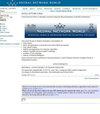A neoteric ensemble deep learning network for musculoskeletal disorder classification
IF 0.9
4区 计算机科学
Q4 COMPUTER SCIENCE, ARTIFICIAL INTELLIGENCE
引用次数: 1
Abstract
The healthcare area is entirely different from other industries. It is of the highly significant area and people supposed to gain the utmost care and facilities irrespective of the cost. Reliable image detection and classification is considered a significant capability in medical image investigation problems. The key challenge is that the whole image has to be searched for a particular event and then classified accordingly but it is necessary to ensure that any important piece of information or instance shouldn’t be skipped. With regards to image analysis by radiologists, it is quite restricted because of its partiality, the intricacy of the images, wide variations that happen amongst various analysts and weariness. However, the introduction of deep learning is a promising way to improve this situation by sorting out the issue according to human leaning mechanism consequently it brings high-tech changes in medical image classification problems. In this context, a new ensemble deep learning topology is being proposed in the direction of a more precise classification of musculoskeletal ailments. In this regard, a comparison has been accomplished based on different learning rates, drop-out rates, and optimizers. This comparative research proved to be a baseline to gauge the up-to-the-mark performance of the proposed ensemble deep learning architecture.用于肌肉骨骼疾病分类的近代集成深度学习网络
医疗保健领域与其他行业完全不同。这是一个非常重要的区域,人们应该得到最大的照顾和设施,而不考虑成本。可靠的图像检测和分类被认为是医学图像调查问题中的一项重要能力。关键的挑战是,必须搜索整个图像的特定事件,然后进行相应的分类,但有必要确保任何重要的信息或实例都不应该被跳过。关于放射科医生的图像分析,它是相当有限的,因为它的偏见,图像的复杂性,在不同的分析师之间发生的巨大变化和疲劳。然而,深度学习的引入是一种很有希望的方法,它根据人类的学习机制对问题进行分类,从而给医学图像分类问题带来了高科技的变化。在此背景下,一种新的集成深度学习拓扑被提出,旨在对肌肉骨骼疾病进行更精确的分类。在这方面,已经完成了基于不同的学习率,辍学率和优化器的比较。这一比较研究被证明是衡量所提出的集成深度学习架构的最新性能的基线。
本文章由计算机程序翻译,如有差异,请以英文原文为准。
求助全文
约1分钟内获得全文
求助全文
来源期刊

Neural Network World
工程技术-计算机:人工智能
CiteScore
1.80
自引率
0.00%
发文量
0
审稿时长
12 months
期刊介绍:
Neural Network World is a bimonthly journal providing the latest developments in the field of informatics with attention mainly devoted to the problems of:
brain science,
theory and applications of neural networks (both artificial and natural),
fuzzy-neural systems,
methods and applications of evolutionary algorithms,
methods of parallel and mass-parallel computing,
problems of soft-computing,
methods of artificial intelligence.
 求助内容:
求助内容: 应助结果提醒方式:
应助结果提醒方式:


